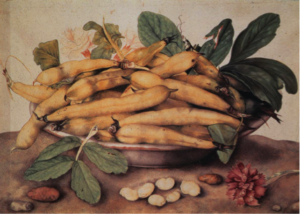By Christine Smudde (Guest Contributor)
Francois Vatel was the well-respected chef to the noble Condé family in the late 1600s. The Condés lived at Chantilly, the ancestral home of the prince of Condé. It was a grand chateau and Vatel took pride in the fine cuisine he prepared and served at the table. One year, he was orchestrating a two-day banquet celebrating the visit of King Louis XIV and his entourage at Chantilly. The event was going to be fit to match even the highest French standards for grandeur. There would be elegant food, music, and festivities. The first day was deemed enchanted and the culinary abundance refined and extravagant, even with the unexpected guests. But, disaster struck on the second day, a Friday and, therefore, a day where meals are centered on seafood due to the laws of the Roman Catholic Church. When Vatel learned that there might not be enough seafood to feed the entire royal entourage, he promptly went to his room, propped his sword against the door, and drove it through his heart. He would rather die than disappoint the king and dishonor his culinary art. Some thought this was a logical response for a chef who thought he had failed to give his royal guests the meal he had planned for them. Others tried to pass it off as depression. But, the fact is that Vatel preferred death to culinary humiliation.
In the 17th century, a chef was the name given to any man who ran the kitchen of a noble household. He had the job of food preparation and arrangement as well as the orchestration of grand feasts such as the one Vatel organized for the king. It was the chef’s job to mediate between art and nature by highlighting simplicity, purity, and honesty of flavors in his cuisine while upholding the French standards of extravagant sophistication and elegance. When someone hears the term French cuisine, they know the food will be elegant and sophisticated even to this day. Adhering to this new standard of French culinary art was a way to uphold the honor of France. In French cuisine, there are only exquisite meals that are beautifully and carefully prepared and served.
the name given to any man who ran the kitchen of a noble household. He had the job of food preparation and arrangement as well as the orchestration of grand feasts such as the one Vatel organized for the king. It was the chef’s job to mediate between art and nature by highlighting simplicity, purity, and honesty of flavors in his cuisine while upholding the French standards of extravagant sophistication and elegance. When someone hears the term French cuisine, they know the food will be elegant and sophisticated even to this day. Adhering to this new standard of French culinary art was a way to uphold the honor of France. In French cuisine, there are only exquisite meals that are beautifully and carefully prepared and served.
The rise of French cuisine as a fine dining experience elevated the chef’s status in the 17th century. A chef dictated the standards of taste to his diners by providing them with food. He must exude the luxury and extravagance in his creations that had become French standard. He must be able to disguise food for consumption. In this case, disguise refers to the preparations that transformed leftover food into new dishes for a new day. Due to the desire for extravagance, there was often an over abundance of food on any particular day. Due to the need for novelty and elegance that was common in the 17th century, the preparations of the leftover food must be creative, sophisticated, and undistinguishable from the fresh plates. A chef must maintain the curtain between preparation and consumption that protects his art. Therefore, ingenuity was a celebrated quality in a chef. It allowed for variation in simple recipes that could satisfy even the most delicate of tastes and avoid culinary humiliation. As we learned from Vitel, French chefs didn’t take dishonor very well.
Bibliography
Beauge, Benedict On the idea of novelty in cuisine: A brief historical insight. gastronomy and food science December 2011.
DeJean, Joan. Essence of Style: How the French Invented High Fashion, Fine Food, Chic Cafés, Style, Sophistication, and Glamour. Free Press. 2006.
Landweber, Julia. “Domesticating the ‘Queen of Beans’: How old regime France learned to love coffee.” Montclair State University.
Davis, Jennifer. “Masters of Disguise: French Cooks between Art and Nature, 1651-1793.” University of California Press. Gastronomica Vol 9 No 1. Winter 2009.

Christine Smudde is a senior at Vanderbilt University majoring in Math and French. She was born and raised in Southern California surrounded by good food and friends. Her passion for food began at a young age when she learned to cook with her mom and grandma. It quickly became an important part of her life and has followed her to college. French food combined her passion for France and food to make a great research project.
